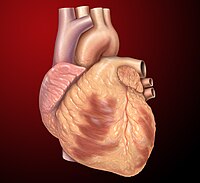
Photo from wikipedia
Abstract Ventricular septal rupture is a life-threatening complication of myocardial infarction, with its surgical repair representing one of the highest risk cardiac procedures. This complex case demonstrates a novel hybrid… Click to show full abstract
Abstract Ventricular septal rupture is a life-threatening complication of myocardial infarction, with its surgical repair representing one of the highest risk cardiac procedures. This complex case demonstrates a novel hybrid approach to decrease the interventricular shunt and an early complication that can occur after initial surgical repair, and the vital role of the anesthesiologist to diagnose and guide both percutaneous and surgical interventions. A 65-year-old woman presented in cardiogenic shock after an anterolateral myocardial infarction with a ventricular septal rupture. Initial surgical repair of her ventricular septal defect (VSD) demonstrated no residual shunt by intraoperative transesophageal echo (TEE) evaluation. However, on POD 6, she again developed cardiogenic shock. Emergent transthoracic echo (TTE) showed patch dehiscence. Attempted resuscitation and repair was then done via percutaneous closure with AmplatzerTM PI Muscular VSD Occluder device. Thirty-two thrombogenic coils were placed along with the occlude device in attempt to reduce the residual shunt. After a period of end-organ stabilization, a redo open removal of AmplatzerTM PI Muscular VSD Occluder with coils and VSD patch repair was done a second time. This sequence of repairs demonstrates a hybrid approach to resolve a deadly condition that resulted in a positive patient outcome.
Journal Title: Journal of cardiothoracic and vascular anesthesia
Year Published: 2020
Link to full text (if available)
Share on Social Media: Sign Up to like & get
recommendations!